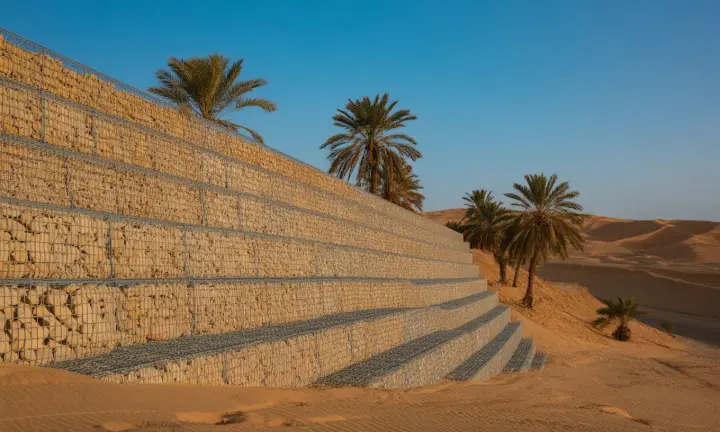The diversity of Saudi Arabia's landscape is challenging and demanding. The terrains require effective engineering and construction solutions, whether they’re arid deserts and expansive coastal plains, or dune fields and mountainous regions. Soil Stabilization here stands as one of the most critically approached challenges for engineers, contractors, and developers. However, soil stabilization is essential to strengthen the soil so that it can perform in supporting roads, buildings, and industrial facilities.
In this blog, you will come across an efficient solution to soil stabilization for harsh terrains and some common challenges the constructor faces.
The Harsh Terrains Of Saudi Arabia
Saudi Arabia covers a diverse range of terrains, including:
🏜️ Deserts (e.g., Rub’ al Khali – the Empty Quarter)
🏞️ Mountain Ranges (e.g., Sarawat Mountains)
🏖️ Coastal Flats (Red Sea and Arabian Gulf regions)
⛰️ Gravel Plains and Rocky Plateaus
What Is Soil Stabilization?
Soil stabilization is the process of strengthening the physical attributes of the soil. Its ability to bear capacity, distribute load, resist water, and withstand compaction is improved via mechanical or chemical means. Soil stabilization helps level the ground for constructing buildings, warehouses, and roads. It prevents erosion and controls unprovoked landslides, increasing the sustainability of the infrastructure and reducing maintenance costs. Transformation of unstable soil into a structured load-bearing layer ensures stability.

Primary Soil Stabilization Challenges In KSA
The most common soil stabilization challenges faced by people in KSA are listed below:
Dry Land
Deserted lands in Saudi Arabia have a very low percentage of cohesion and a high permeability value. It makes it difficult for makers to provide strength to the soil without modification to ensure structural stability.
Expansive Soil
Areas with clay-rich soil tend to swell when they become wet and shrink when they are dry. The disparity in soil movement leads to layer movement and cracks in the foundational base and pavements.
Sulfate-Concentrated Land
Coastal and inland sabkhas (salt flats) soil is highly sulfate-concentrated. The amount of sulfate stabilizes with agents such as lime and cement, resulting in a reduction of the effectiveness of the soil.
Wind Deflation And Erosion
Open landscapes such as roads and embankments are vulnerable to wind erosion. It gradually blows away the topsoil and drifting sand particles, creating an unstable surface.
Compaction
Conventional compaction requires plenty of water for its chemical integration, and water in KSA is scarce. It can become difficult for the engineers to level the surface.
Innovative And Key Soil Stabilization Solutions In KSA
Gabions and Retaining Walls
Gabions are wire mesh baskets filled with stones and aggregate to stabilize slopes, retaining walls, and embankments. These are highly effective in mountainous and rough terrain areas for natural drainage without any hydraulic buildup, flexible movement, and sustainable integration with the land. Gabions and retaining walls are an aesthetic solution for soil stabilization and slope structure.
Geogrids And Textiles
Geosynthetic materials include geotextiles and geogrids, which control deformation and retain soil. These grids are laid under platforms, railbeds, and roads to offer separation and filtration functionality and tensile reinforcement for weaker soils. These are ideal for marshy and dry areas that require soil stabilization for compaction.
Soil Anchoring
Soil nails and rock anchors are interspersed in the ground to foster passive resistance and support structures in terrains like Taif or Abha. It retains structure in areas with steep slopes, slipage-prone landscapes, and hilly zones. One can add mesh fencing and shotcrete in soil nails for efficient resistance.
Chemical Stabilization
Agents such as cement, lime, fly ash, and an enzymatic stabilizer are infused with clay or silty soils to escalate the load-bearing strength and water resistivity of the soil. It improves the sub-base and binds moisture in soil for efficiency.
Aggregate Layers
The most cost-effective manner of soil stabilization is incorporating compact aggregate layers of crushed rocks and well-graded gravel. Used in tandem with geotextiles, it enhances the stability of roads, construction yards, and laydown spaces. They highly encourage drainage and load distribution, reducing soil displacement.
Vision 2030: Integrating Stability And Structure
With KSA’s Vision 2030, soil stabilization plays a key role in supporting the narrative. It helps reduce resource waste at construction sites and protects the natural landscape from landslides and erosion. Soil stabilization promotes recycled energy infrastructure and solar farms, maintaining the efficiency of the soil. It enables to provision of stability in vulnerable areas like AlUla, an eco-friendly project.
Hitech Gabion delivers durable stabilization solutions engineered from modular techniques, natural substances, and eco-consciously produced.
Conclusion
Soil stabilization in Saudi Arabia is essential to maintain the structural stress, stability, and load-bearing capacity of the landscape. The sustainable pavements enable them to resist cracking, rutting, and subsidence in expressways and industrial facilities. It also ensures a safe ground base for buildings in King Abdullah Economic City, residential zones in Riyadh, and downstream development in Wadis. Soil stabilization is a modern solution for rapid urbanization in Saudi Arabia, creating a safe and stable land.
Hitech Gabion is your trusted and reliable partner in supplying cost-effective and efficient solutions for soil stabilization. Request a quote now!